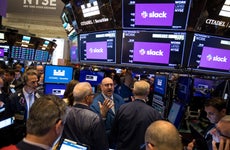Large-cap vs. small-cap stocks: Key differences to know

The Bankrate promise
At Bankrate we strive to help you make smarter financial decisions. While we adhere to strict , this post may contain references to products from our partners. Here's an explanation for .
Large-cap stocks and small-cap stocks – the two sound similar, but offer entirely different risk profiles as well as potential for returns. Knowing how to discern between the two is crucial when building out your own portfolio and managing investment expectations.
Here’s what investors should know about large-caps and small-caps and their key differences.
What are large-cap stocks and small-cap stocks?
When investors discuss large-cap stocks and small-cap stocks, they’re referring to the value of all the company’s outstanding shares, referred to as its market capitalization or market cap. This number is found by multiplying the total number of shares by the share price.
For example, a company with 10 million shares outstanding selling at $10 a share would be said to have a market cap of $100 million. This figure represents how valuable the public perceives a company to be. The number can be driven by hype, popularity or other short-term optimism as well as estimates of a company’s long-term value.
So large-cap stocks are those with a relatively large market cap, while small-cap stocks have relatively low market caps.
Large-cap stocks
Large-cap stocks, also commonly referred to as big-cap stocks, are the largest companies, typically holding a market capitalization of $10 billion or more, though that threshold rises as more companies exceed it.
Large-cap stocks are generally considered to be safer investments than their mid- and small-cap stock counterparts because they are larger, more established companies with a proven track record. Some of the biggest names in business are large-cap stocks – Apple, Microsoft and Alphabet, for example.
Small-cap stocks
Small-cap stocks are companies with market capitalizations of $300 million to $2 billion. Small-caps sit at the lower end of the market-cap spectrum, and as they expand, they can become mid-caps and then ultimately large-caps, if they achieve big enough growth.
Small-cap stocks have historically outperformed their larger counterparts, but investment into this asset class should be approached with caution and suitable risk tolerance. They tend to offer higher returns in exchange for higher investment risk.
Key differences between large-cap and small-cap stocks
While they’re both stocks, large-caps and small-caps differ along a few key dimensions.
Growth potential
Large-cap companies usually operate in mature but growing industries. Banking and big tech are examples, though these industries also feature many small-caps, too. Large-cap companies will often have well-established lines of business, but with tighter room for growth.
”Large-cap stocks suffer from the law of large numbers financial theory, which states that a large organization or collection that is rapidly expanding cannot maintain its rapid growth indefinitely,” says Bryan Shipley, CFA, chief investment officer of advisory firm Americh Massena. “Whereas when small companies expand, a high growth rate is easier to sustain.”
In contrast, small-cap companies often operate in growing industries, and might still be developing. The trade-off here is that small-cap companies have more room to grow and can offer investors higher return but with higher risk.
From 1926 through 2020, small-cap stocks, on average, outperformed large-cap stocks by 1.6 percent, says Robert R. Johnson, Ph.D., professor of finance at Heider College of Business at Creighton University. “That may not sound like much of a difference, but with compounding, that return difference is huge. One dollar invested in a large-cap index would have grown to $10,944.66 by year-end 2020. One dollar invested in a small-cap index would have grown to $41,977.83 by year-end 2020.”
Financial resources
Large-cap companies will have different, and more robust, financial resources than small-caps that are likely still building. Large-caps often generate a lot of cash, and will be more easily able to use cash reserves to cushion potential problems. Large-caps also have strong stocks they can use to raise capital in the event of a downturn, in addition to having easier borrowing capabilities than small-caps because of their track record and size.
Large-caps also often own other assets (like existing cash, stocks, property, stores, equipment, merchandise and more) they can borrow against. Small-caps may have more limited resources, and have a tougher time raising money in debt markets.
Volatility
Volatility is another key difference between small-caps and large-caps. Small-cap companies are often earlier in their lifecycle and may be more susceptible to economic downturns, which could cause their business to suffer or access to financing to dry up. These factors can lead to greater volatility for small-cap stocks.
In contrast, large-caps usually experience less fluctuation in the value of their stock. Their business and financial resources are deeper and stronger, and their competitive position means they recover more quickly, whereas small-caps might not survive similar droughts. If they do, they’ll experience more volatile swings in value unlike their larger counterparts.
Dividends
Large-cap companies are far more likely to pay out dividends to their investors than small-cap companies are. Larger, more stable companies operate in mature, slower-growing industries and are often cash cows that can dole out profits to their shareholders. In contrast, smaller, up-and-coming companies often operate in fast-growing industries and need to invest for growth. So they don’t have the financial resources to pay dividends.
Business strength
A key difference between large-caps and small-caps is the overall strength of their business.
Large-cap companies are “able to absorb costs better than small caps, negotiate with suppliers or even pass costs down to consumers easier than small caps,” says Anessa Custovic, Ph.D., chief investment officer, of Chapel Hill, North Carolina-based Cardinal Retirement Planning. “This means they are less likely to see earnings hits when costs rise as they can absorb this. They can be less sensitive to consumer sentiment and macro conditions since they are larger and more established.”
Large-caps also tend to have more diversified lines of business, which also helps during downturns. In contrast, small-caps tend to be more focused on a few lines of business, so they’re more sensitive if something happens to one of those businesses.
Which should you choose for your portfolio?
Choosing between large-caps and small-caps ultimately comes down to your goals and how much risk you are willing to tolerate, but both have their place in a well-diversified portfolio.
- Large-caps: Stable returns with less room to grow. Possible dividend payouts.
- Small-caps: More volatile, but with the potential for growth and higher returns.
- Blended approach: Diversification in small-cap volatility hedged by possible dividend payouts and/or small, steady returns by large-caps. Higher ratio of large-cap to small-cap will be the safest way to start.
“If your goal is long-term wealth accumulation, history would indicate that small caps are preferred over large caps,” Johnson adds. This of course, comes with the price of volatility and being able to weather a potential impending downturn.
A buy-and-hold strategy works for both, but an investor will need to expect varied returns.
Bottom line
Both large- and small-cap stocks have value in one’s portfolio.
Large-cap stocks are investment mainstays that provide stability and consistency through their size, breadth, and financial resources they can draw on to hedge downturns and sometimes even pay dividends back to their investors.
Small-cap stocks are riskier and more volatile investments, as they do not have the same financial resources large-caps do and are still developing their businesses. Each has their purpose for investors: small-caps can provide growth but will be risky, whereas large-caps have less room for growth but will provide less volatility.
Editorial Disclaimer: All investors are advised to conduct their own independent research into investment strategies before making an investment decision. In addition, investors are advised that past investment product performance is no guarantee of future price appreciation.
Related Articles



Direct listing vs. IPO: Key differences and how to choose an investment
